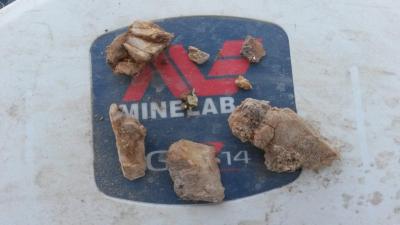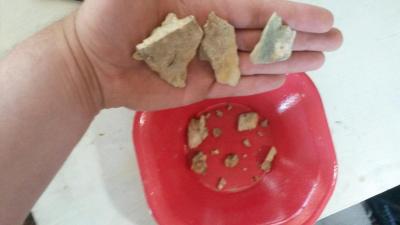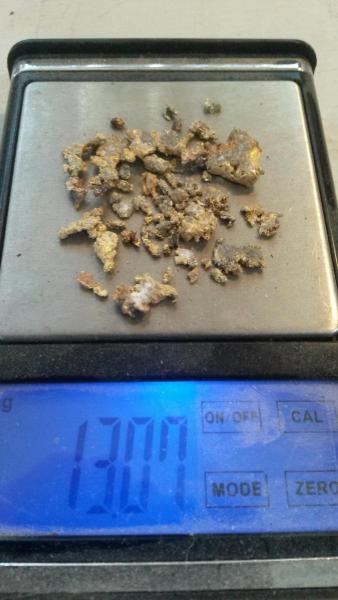-
Posts
2,465 -
Joined
-
Last visited
Content Type
Forums
Detector Prospector Home
Detector Database
Downloads
Everything posted by jasong
-
Does anyone have a vid link to a nugget going low-high (filmed after the update only) that shows how deep it was and how big the nugget was? On nuggets up to 40 grams I still cannot get a low-high signal with just one exception and that is squirrly little wiry or thin flaky pieces that flip between high-low and low-high, and with some regular pieces when they get really close to the coil they will flip between the two as well. I had a 65 gram slug of solid smelted gold and it was going high-low on the GPZ. It was low-high on my 45 though. What I'd really like to see are the types of gold that are low-high from beginning to end, no matter how far from the coil. If anyone has some links or has such a nugget and could toss it on the ground and film it I would be very grateful. One reason I'm wondering (ok, don your tinfoil hats) is low-high is so often iron now that I can't help but wonder if discrim might be possible with ZVT tech and there may be some kind of "discrimination update" coming in the future. Also, bonus question: can anyone show me a case where General is outperforming High Yield in depth and sensitivity and what exactly the type of gold (weight/sponginess/etc) is that causes such a thing to occur? Or ground type if that is causing the difference. We see it on the ML chart (or it would appear that way but we don't know for certain due to omission of actual sample defintion), but I haven't found a case with my gold where it happens yet so I'm curious what to look out for or if I should just give up on going back with General after HY unless I have gold past a certain size threshold.
-
I'm not sure I follow what you mean by tracing mineral ownership through public land and patent information? The only way I've found to trace current mineral ownership any more accurately than the ownership data the BLM has is to follow the chain of title, one individual deed at a time. Same way we do it in the oilfield. It's impossible on any sort of large scale. It can take days for just a single property and often has to be done in the office itself since a lot of counties don't have deeds online or if so only going back to like 1970, which is why title agencies charge for it and why the BLM database would be incredibly useful. The BLM does have some kind of mineral ownership database it's just not entirely centralized and each state hq manages it differently is the impression I got. The response I got from the lead GIS guy in Denver (where my pursuit ended) was that O&G and Landmen pay millions of dollars a year for subscriptions to access that exact database which is parsed and a frontend provided by some 3rd party corporation which pays them some large sum of money for exclusive access to that data so they can resell it. And this is why they don't give the data to the public (despite it being public data, argh). The BLM guy flatout told me I should probably give up. Anyways, are you saying the BLM did offer you access to their Arizona mineral ownership database and you viewed it and judged it innaccurate? If so, can you direct me to where I can download it (Nevada too)? I don't care if it isn't accurate, its better than nothing. For instance, the Colorado one quickly shows patterns that I can look deeper in at the county recorder if I decide to. Things like large areas where the railroads traded off their minerals, places where withdrawls took place, etc, I just need to see the pattern, I don't need it to be 100% accurate.
-
Hey Barry, have you had any luck getting mineral ownership data from the BLM? I've got a couple shapefiles from a few states like Colorado and New Mexico, but I can't seem to find anyone that has them for other states like AZ and NV. I know they have to have the data somewhere otherwise they couldn't make their mineral paper maps, but they just kept telling me they didn't have the data no matter who I spoke with until I just gave up trying. Saw that you have them as a potential future map layer so was wondering if you had any more luck than I did and if so where a guy can get it. I'm also on that LR2000 bi-monthly distro so I have access to their servers where that data is hosted if it makes any difference, but its just LR2000 stuff in there from what I can tell.
-
The desert pavement is one instance of what I'm talking about. I'm not much of one for suspense or guessing, so I'll just say it. It's called "deflation" and its very common in the desert SW and can form concentrated little patches if you get many tens of feet worth of deflated gravel over tens of thousands or a hundred thousand years. The wind blows away the fluff slowly but steadily but the nuggets remain as the ground level keep decreasing. A lot of those areas were flogged by the early VLF'ers though, piles of old 9V's laying around them are around testament to that. I think in a lot of cases most the gold was in the first 6-10 inches and then there wasn't much concentration beneath it where deflation hadn't really set in as much (it works from the surface down after all). I never really understood why I didn't find much more in those patches with my PI until I started finding them virgin and realize that there really just wasn't much gold deeper. But there is still one more very common place to find nuggets right in the middle of washes at or near surface though. And while it has a bit to do with erosion it has little to do with flooding or tailings.
-
Your 6 ouncer find might be very similar to the same conditions which cause nuggets to be found right on or right beneath surface in nothing but fluffy dirt or maybe some clay in NNV. Which is 1 of 2 specific instances I mentioned above and I think Reno Chris was probably thinking about mentioning something about it too and maybe still will. Something like letting the air out of a raft...what is that word. . BTW, I'm gonna kinda steal and change your "detective detectorist" phrase and use "Metal Detectives" as the title for a little series of shorts.
-
There are a few specific instances where I commonly find nuggets in the float or right on or near surface and two of them are important enough that all prospectors should know about them. The problem is shallow nuggets are much less common in popular areas so it's easy to think they just don't exist because they were mostly found and removed decades ago. Look at how many pounds of nuggets guys pulled out of Q right on or near surface though back in the 70's and 80's, and that was in gravel (not tailings) that can be up to 20ft thick. Especially true in the desert SW. But I found quite a few up in NNV within a few inches of surface too and not even in gravel, just in fluffy dirt or clay. It is coincidentally the subject of a video I'm currently making so in the spirit of this thread I guess I'll leave it to people to guess what I'm talking about if they don't know already.
-
Sounds like shale and looks kinda like it too maybe? I think that's what mine was in and the vein was all squirrely and hard to track since the rock is so fractured. It'd be there, then it'd be 8" over to the side, then it'd just turn into a conglomerate/breccia looking pod of mishmash cemented together by some muddy carbonate looking stuff. Mine was way smaller than what it looks like you have going on though, that's cool! I hope you find some big pockets.
-
Any idea what that brownish material is? Do you think maybe its from the wall rock/vein contact zone? I found some similar stuff where the vein was in this weird brownish rock like that which I couldn't identify. The quartz was solid and chunky at first as I started into the vein and towards the walls had bits of the wall material embedded in it (or vice versa), then at the bottom there was a softball size "hole" where everything was broken up and I got a couple handfuls of chunks out kinda like in your photo that all had crystalline gold like yours too, some was in the wall itself. I just crushed mine up though and smelted them since I had to sell it. The second photo the pieces in my hand are washed off and you can see some of the brownish material. Not sure if it was altered quartz or altered wall material or what, but in the sunlight and in person it looked similar to your big chunk there.
-
Drusy quartz is that stuff that looks fluffy or puffy kinda but when you look close it's not a solid quartz face but made of many hundreds of tiny crystals. A drusy vug must be filled with that kind of stuff I think. I tend to think along the lines Root is talking about where the vugs are not indicators of gold themselves but just give larger minerals room to grow, including gold. So when we see vein material containing vugs its worth investigating closer. Rick, your attachements didn't show for some reason, any chance you could try again? Sounds like an interesting find!
-
Thanks Rob, appreciate the compliment. I believe the coal thing Norvic, I'd be interested to see a photo of it if you get one with all 3, gold quartz and coal. Actually, I'd buy a specimen like that probably and I've never bought a piece of gold in my life, only sold it. In Wyoming, where the largest (or used to be largest?) open pit coal mine in the world lives right north of me, there is occasionally coal which has micron to even very small pieces of gold visible with a loupe. It's all real small and definitely no quartz though. The mudmen would swear up and down we'd be getting gold over the shaker screens ocassionally drilling through parts of the the Wasatch too, which was mostly shale some coal seams. Never saw it myself though since I had to be on the rigfloor anytime we were in soft stuff (was a directional driller).
-
Tvanwho, those three sample in my videos are all pseudomorphs of pyrite if you'd like to see an example. In specific they are Hematite after Pyrite. The black cube inclusions are what I'm talking about. I don't know a lot about fossils, but when you think about it, it can be a similar process. Chert or something fills in and takes the form of a what was once a fish. Or have you seen those pyrite ammonites? I think you could call those pseudomorphs, one mineral is replacing biologic matter instead of replacing another mineral. Or whatever is happening, I honestly don't know a lot about fossils and fossiliation. Phyllite can be blueish looking though its metamorphic, if you are referring to NNV? I'm guessing it probably weathers into something like clay too. But those would definitely be questions better answered by someone like Reno Chris than myself. Personally I've only found blue clay once when I was dredging. Mostly the clay I dig into when I detect is reddish from iron oxidizing. What I can say from my time in the oilfield is shale can be many colors from pale white to jet black.
-
One thing which I didn't include in the video because honestly I don't understand enough about geochemistry is a bit more on iron oxides/sulfides and their association with gold. I've observed time and again that nuggets very commonly have hematite inclusions but only rarely do they have magnetite inclusions. Now, both are iron oxides and pretty similar chemically speaking, so why is it so common that we find hematite included but not magnetite? Note: I'm not talking about black sand concentrations where the magnetite is associated with gold because of natural gravity separation here. Also, yes occasionally we do get those odd "magnetic" nuggets with magnetite inclusions but they are rare except in specific places. A few years ago a metallurgist friend and fellow prospector ran his dredge cons through the spectrometer and a SEM (scanning electron microscope) and found the same thing, that the only black sand particles which contained gold were the hematite particles. And thus a guy could safely remove all the magnetite via a magnet before crushing and processing his cons and thereby reduce the amount of material to be processed greatly. Well, after talking to NVChris earlier this year where he mentioned pseudomorphs it got me thinking about the subject further. Magnetite rarely forms a pseudomorph after pyrite but it's very common for hematite to do so. Even more common is Goethite after Pyrite though. So as the year has progressed I've been testing every nugget I find with a "blackish" material included and I've found that in fact a number of nuggets actually contain Goethite when I used to just assume it was hematite. They look very similar but Goethite will streak more yellowish than Hematite which is earthy red and pretty unmistakable. So, I think one reason (among many others) we find hematite and goethite commonly included into gold nuggets themselves is their tendency to form pseudomorphs of pyrite, and in the crystalline world, the real strong association is actually with pyrite which was the original mineral and later gets altered and frees up its gold. So, this is why I stress that it's important to look for pyrite casting in your nuggets that you find and to pay attention when you start seeing large pyrite crystals or pseudomorophs of pyrite in the country rock or vein material itself. Cubic cross sections can be quite deceiving so it's helpful to take a cube in hand and imagine what certain negatives (casts) would look like if the cube was cut from various angles and in different parts. The angles will not always be 90 degrees depending where you slice the cube at. But again, I'm not a geochemist or a geologist, these are just observations and I'm not comfortable enough with their correctness to have included it in the video but it may be worth considering just on a theoretical basis.
-
I'm happy to know this video is promoting discussion. These kinds of videos get the least amount of views but for me this is the most interesting part of prospecting - the mystery and figuring out how to solve it. Gold to me is just the final punctuation on the last page of a detective novel, the proof that a theory was right (or wrong). I live for the puzzle and adventure! Norvic: I know very little about Aussie geology and I've never been there so your observations are likely correct for your conditions. Many of my videos are US-centric because this is the only place I've prospected. I've prospected all the western lower-48 except WA and ID and these are some threads I find in common no matter what state I am in. Granted, even here there are exceptions and I haven't been east of the Mississippi so even out there it may or may not apply. When I talk about "big" gold I mean anything that is detectable size. Not all my subscribers are detectorists where our definition of big gold means something different. For example, in CO I only personally know of 3 nuggets found in the last 10 years larger than 1/4 ounce, but I still observe many of the same conditions producing that nuggety gold there as I do in Arizona where larger gold is more common. Often (but not always), I observe larger gold is found in the smaller veins and within pockets and not in massive quartz. Definitely are some notable exceptions to that rule as well though. We really are part detective as prospectors, the more we keep our eyes open and make observations the more successful we can be I think.
-

Small Scale Hardrock (Lode) Mining
jasong replied to Quick's topic in Rocks, Minerals, Gems & Geology
Interesting, yeah I don't know much about assaying without a spectrometer so it'd be good to know exactly what the oldtimer was doing with that suitcase. I haven't been concentrating much on the hanging and foot wall portions during sampling, I'll have to start doing that. -
Cool, yeah I understand. I've always suspected a DD in Sens Extra can outperform (or at least equal) a mono in Enhance in some cases here in AZ too when the ground gets tough. Almost every coil on a Minelab in the field here in the US is a mono, DD's are underutilized when the ground gets bad over here just because so few people have experience with them or even still own them. Are those Detech's spiral wound like the NF/Coilteks? What about the new DD's, whats different with those, are they spiral wound too on each lobe or something?
- 11 replies
-
Good vid, thanks. That 12 looks like a hot little coil. Do you think the performance of the DD was due to running it in Sens Extra instead of Fine Gold like the other coils?
- 11 replies
-
I LOL'ed heartily.
-

Small Scale Hardrock (Lode) Mining
jasong replied to Quick's topic in Rocks, Minerals, Gems & Geology
Yeah, I've seen those, but my mortar and pestle crush ok already and are much more portable. The problem is the water and my lack of a burro to haul it up mountains with me. It takes a ton of water to pan tests all day, not feasible and I wonder how the oldtimers even managed to do it unless they just took really small samples and only used water for a select few of the most promising. I guess the old timers must have pretty much concentrated on exposures with visible gold. I should mention what I'm asking about is for straight up prospecting. Not going to old mines, just going literally to every promising looking exposure in a promising area and sampling the veins for a totally new mine. No roads or trails, no water anywhere here in the desert, just steep rocky mountains. -
Commercial use is banned and they now require all owners to register with the FAA or face criminal/civil penalties as of a few days ago. https://www.faa.gov/uas/registration/ Just a heads up, they do consider use of the drone with anything at all involving business to be illegal without their permit (including just flying around your yard and posting your vids to Youtube if there are ads on the page), I spent some time looking in to it a while back and gave up. Idiots already ruined it a few years ago, it's inevitable. You get people flying in NY and crashing from 500 ft up over a crowded city, interfering with EMS and firefighting operations, etc.
-

Help Relocate A Snowbound Placer Miner
jasong replied to Underburden's topic in Detector Prospector Forum
Pacific side of Costa Rica. -

Help Relocate A Snowbound Placer Miner
jasong replied to Underburden's topic in Detector Prospector Forum
If I were going to retire anywhere it'd be Prescott, AZ. Perfect year round temps, still get seasons, nice Ponderosa forests, plenty of gold, nice town with older buildings with historic character. Flagstaff is awesome too but further from gold (and very snowy). Anywhere else in AZ is too hot for my tastes personally, as a guy also hailing from a chilly climate. Durango, CO would be my second choice, but it's probably too cold and snowy there. -

Small Scale Hardrock (Lode) Mining
jasong replied to Quick's topic in Rocks, Minerals, Gems & Geology
I think your spot on there Chris. On another subject, is there some kind of simple, lightweight method to sample in the field? Right now I just bag everything up, put it in my backpack, and hike around with a bunch of rocks until the day is over. Then I crush them up at my trailer and pan it out there. But I'd be nice to do it all in the field and be able to follow leads while I'm out there to concentrate prospecting efforts more. A GB2 does the job well if there is enough gold and large enough, but samples can easily run 1 oz/ton and be disseminated enough to not make a peep on the detector still so it isn't sufficient. I wanted an XRF gun for (among other things) this. But they have their own limitations and problems for this kind of use, and way out of my price range anyways. Any other good alternatives? -
Haha I like it!
-
Cool, thanks for taking the time to answer questions.





